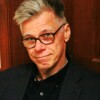Inside Science Minds: A Perspective on the 2011 Nobel Prizes

The diffraction pattern for quasicrystals (left) and a galaxy-filled image from the Hubble Deep Field (right) look similar, but the dimensions between atoms and galaxies differ by about 100 million trillion trillion times.
ISNS | NASA | Shechtman
(ISM) -- The idea that the expansion of the universe is not slowing down, but actually speeding up, represents the biggest turnaround in thinking in physics over the past 30 years. So it’s appropriate that the three men chiefly responsible for this stupendous finding, Saul Perlmutter, Adam Riess, and Brian Schmidt, will be traveling to Sweden to receive the 2011 Nobel Prize in physics.
Their work, depending on careful measurements of exploding stars called supernovas, is just the latest in a long succession of revelations from the sky. Cosmology, the study of the universe, has long been a keen interest of the human race. Starting more than 3,000 years ago, Chinese and Babylonian astronomers recorded celestial activity, such as eclipses and the coming of comets, and slotted their sightings into broad explanations of how the universe operates.
Cosmology can be practical, since it has helped farmers time their spring plantings, and religious, since some cultures have used it to map divinity in a geometric way. Ancient Greek cosmology, for example, depicted Earth as the center of a stately procession of planets and stars that rose and set in predictable patterns. Humans were at the center, and gods were all around the outside.
When someone dared to suggest a new way of viewing the heavens, the result could be disturbing. Galileo, loudly promoting Copernicus’s idea that Earth was not the center of the cosmos, was put under house arrest. The priest Giordano Bruno was burned at the stake in the year 1600, partly for his assertion that the stars we see at night -- perhaps an infinite number of them -- are probably a lot like our own sun in that many of them had their own planets, possibly inhabited by creatures much like ourselves.
We don’t burn astronomers anymore. In fact, we sometimes give them a million and a half dollars to share when they helpfully disrupt prevailing attitudes. Whether or not Alfred Nobel endowed his famous awards to assuage his conscience for having invented dynamite and sold a lot of cannons, his prizes generally reward superior efforts to widen our knowledge of the universe. This includes not just the universe visible in the sky but also the cosmos inside atoms.
The Nobel Prize for chemistry, awarded to Dan Shechtman, recognizes the discovery of a material that possesses a structure with a seemingly forbidden fivefold symmetry. The common view at the time of his research was that crystalline solids could be constructed, on the submicroscopic level, of atoms that sit in repeatable units of three, or four, or six, but not five. When Shechtman contrived a material that did indeed feature a fivefold grouping, many of his colleagues could not accept the idea. Shechtman persisted in his claims, and eventually the very definition of what constitutes a crystal had to be changed. Shechtman had helped to widen the universe. In his pictures atoms are billionths of a meter apart. In the best pictures taken by the Hubble Telescope, galaxies are billions of trillions of meters apart. But the pictures look arrestingly alike.
The new physics Nobel winners studied how most visible galaxies are receding from each other as part of the grand expansion of the universe itself. They used light coming from deep space to calculate the distance from Earth to distant supernovas and their velocity relative to our planet to determine how fast space itself was expanding in various parts of the universe.
What they found was astonishing. Galaxies are supposed to tug on each other with the force of gravity, and this ought to rein in the ongoing expansion. Given that circumstance, two main outcomes presented themselves: the universal expansion would continue forever but at an ever slower rate, or the expansion would slow, stop, and even reverse, resulting in a big crunch billions of years later.
But which of these two alternatives were correct?
The supernova-observing teams provided a stunning answer: neither. The expansion was actually speeding up. Many scientists, accustomed to the conventional expectations, felt the new findings were wrong.
But other observations soon confirmed the supernova data. Capitalizing on the new input, cosmology was quickly updated, as if it were a form of computer software. Not taking centuries or decades, but only a few years, astrophysicists decided that there must be some new influence out there in space, some form of anti-gravity that can overcome the gravitational pull among the galaxies. This phenomenon, usually going by the name of “dark energy,” is so new that we don’t yet know much about it.
One thing that seems to be accelerating even faster than the expansion of the universe is the expansion of human culture, particularly the enterprise of science. Already a swarm of thinkers are trying to explain or measure the mysterious dark energy. And as soon as they accomplish that goal, some other mystery will present itself and need explanation.


